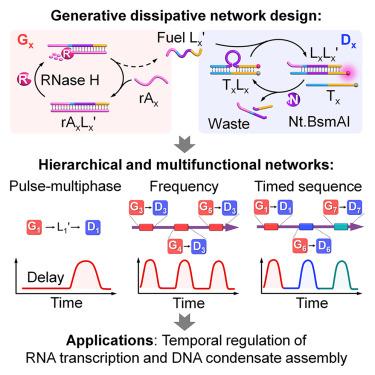设计生成耗散网络规划复杂的时间动态和函数
IF 19.6
1区 化学
Q1 CHEMISTRY, MULTIDISCIPLINARY
引用次数: 0
摘要
复杂的时间动态编排的自然网络是必不可少的细胞功能。在简化的合成网络中复制这些动态可以阐明潜在的机制,促进类生命系统的创建。在此,我们介绍了一个通用的、模块化的、可编程的框架,用于构建能够产生复杂时间动态的分层和多功能生成耗散网络(gdn)。该框架涉及两种类型的模块。生成模块产生燃料,耗散模块消耗这些燃料来激活瞬态信号。通过集成多个模块,构建了具有不同组成、大小、连接方式和拓扑结构的层次化gdn,实现了精确的脉冲多相控制、脉冲重复调频和多脉冲程控定时等可控的复杂时间动态。这些动态源于异质模块之间的协调和同质模块之间的竞争,正如动力学建模所证实的那样。此外,gdn为自主时间功能的编程提供了一个强大的平台,例如gdn介导的RNA转录和DNA凝聚动力学的时间编程。本文章由计算机程序翻译,如有差异,请以英文原文为准。


Designing generative dissipative networks for programming complex temporal dynamics and functions
Complex temporal dynamics orchestrated by natural networks are essential for cellular functions. Replicating these dynamics in simplified synthetic networks could elucidate underlying mechanisms, facilitating the creation of life-like systems. Herein, we introduce a versatile, modular, and programmable framework for constructing hierarchical and multifunctional generative dissipative networks (GDNs) capable of producing complex temporal dynamics. This framework involves two types of modules. Generative modules produce fuels, and dissipative modules consume these fuels to activate transient signals. By integrating multiple modules, hierarchical GDNs with diverse compositions, sizes, connections, and topologies were constructed to produce controllable complex temporal dynamics, like precise pulse-multiphase control, pulse-repetition frequency modulation, and programmed timing of multiple pulses. These dynamics stem from coordination among heterogeneous modules and competition among homogeneous modules, as corroborated by kinetic modeling. Furthermore, GDNs offer a robust platform for programming autonomous temporal functions, exemplified by GDN-mediated temporal programming of RNA transcription and DNA condensate dynamics.
求助全文
通过发布文献求助,成功后即可免费获取论文全文。
去求助
来源期刊

Chem
Environmental Science-Environmental Chemistry
CiteScore
32.40
自引率
1.30%
发文量
281
期刊介绍:
Chem, affiliated with Cell as its sister journal, serves as a platform for groundbreaking research and illustrates how fundamental inquiries in chemistry and its related fields can contribute to addressing future global challenges. It was established in 2016, and is currently edited by Robert Eagling.
 求助内容:
求助内容: 应助结果提醒方式:
应助结果提醒方式:


